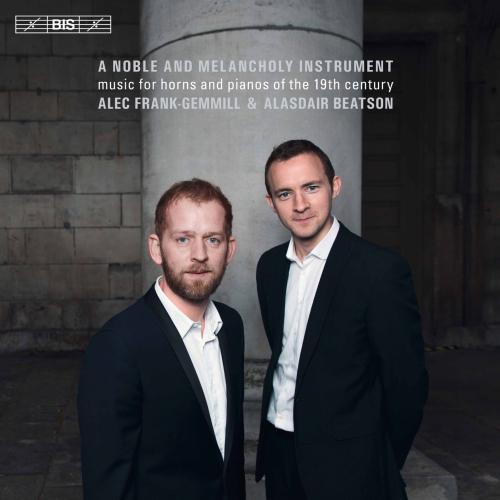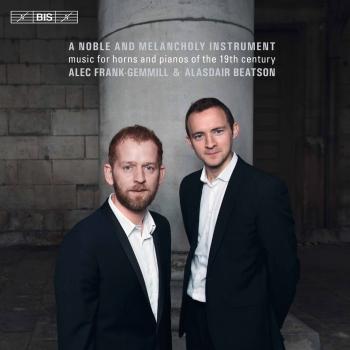
A Noble & Melancholy Instrument Alec Frank-Gemmill & Alasdair Beatson
Album info
Album-Release:
2017
HRA-Release:
07.04.2017
Label: BIS
Genre: Classical
Subgenre: Chamber Music
Artist: Alec Frank-Gemmill & Alasdair Beatson
Composer: Ludwig van Beethoven (1770-1827), Robert Schumann (1810-1856), Franz Strauss (1822-1905), Gioacchino Rossini (1792-1868), Camille Saint-Saens (1835-1921), Alexander Glasunow (1865-1936), Paul Dukas (1865-1935), Gilbert Vinter (1909-1969)
Album including Album cover Booklet (PDF)
- Ludwig van Beethoven (1770-1827): Horn Sonata in F Major, Op. 17:
- 1 I. Allegro moderato 08:30
- 2 II. Poco adagio, quasi andante 01:22
- 3 III. Rondo: Allegro moderato 04:56
- Robert Schumann (1810-1856): Adagio & Allegro for Horn & Piano, Op. 70:
- 4 Adagio 04:30
- 5 Allegro 04:58
- Franz Joseph Strauss (1822-1905):
- 6 Nocturne, Op. 7 05:35
- Gioachino Rossini (1792-1886):
- 7 Prelude, Theme and Variations 10:18
- Camille Saint-Saëns (1835-1921):
- 8 Romance in E Major, Op. 67 07:46
- Alexander Glazunov (1865-1936):
- 9 Rêverie, Op. 24 03:33
- Paul Dukas (1865-1935):
- 10 Villanelle 06:44
- Gilbert Vinter (1909-1969):
- 11 Hunter's Moon 06:20
Info for A Noble & Melancholy Instrument
The 19th century saw huge developments in the design of many musical instruments. In some cases changes were adopted more or less universally: the fortepiano that Mozart knew, a five-octave instrument constructed entirely of wood, had by around 1900 grown into the modern grand piano with over seven octaves and a cast-iron frame. With other instruments progress was less streamlined. As late as 1865, the natural, valveless horn of Beethoven's time remained the instrument of choice for Brahms when he wrote his famous Horn Trio, and when valves began to be introduced, makers and musicians in Germany, France and Vienna favoured different solutions, offering different results in terms of sound and requiring different playing techniques.
The present disc is a unique combination of recital and history lesson, with a young British team performing music from between 1800 and 1942 on no less than eight different historic instruments: four horns and four pianos. This gives us the opportunity to hear the works on instruments that the different composers would have recognized, whether Beethoven's Sonata in F major (a natural horn from 1800 and a fortepiano from 1815) or the Villanelle by Paul Dukas from 1906 (an early 20th-century cor à pistons and a Bechstein from 1898). Both notable performers on modern instruments, Alec Frank- Gemmill and Alasdair Beatson here revel in the sonic possibilities offered by the historic instruments with results that are as delighting as they are enlightening.
Alec Frank-Gemmill, horn
Alasdair Beatson, piano
Alasdair Beatson
Scottish pianist Alasdair Beatson works prolifically as soloist and chamber musician. Highlights of 2017 include concerts in London’s Wigmore Hall and Kings Place, Zurich’s Tonhalle, West Cork, Ryedale, Resonances and Ernen festivals, and collaborations with Adrian Brendel, Philippe Graffin, Pekka Kuusisto, Alexander Melnikov, Pieter Wispelwey, the Doric String Quartet, Meta4 and the Nash Ensemble among many.
Alasdair is renowned as a sincere musician and intrepid programmer. Alongside a particular affinity with the classical repertoire and the music of Schumann and Fauré, he often explores the more exotic: Catoire, Pierné, Thuille; Debussy’s Jeux (in the composer’s arrangement for solo piano); Ligeti Horn Trio, Thomas Adès Piano Quintet; and piano trio arrangements of Debussy’s La Mer, Janacek’s Kreutzer Sonata, Shostakovich’s 15th Symphony (with 3 percussionists) and Schönberg’s Verklärte Nacht. His concerto repertoire includes works of Bach, Bartok, Fauré, Hans Abrahamsen, Hindemith, Mozart, Sally Beamish, Stravinsky, Messiaen, appearing in recent years with Britten Sinfonia, Moscow Virtuosi, Scottish Chamber Orchestra, Scottish Ensemble, Royal Scottish National Orchestra, Sønderjyllands Symphony Orchestra and Tapiola Sinfonietta.
2017 sees the release on BIS of a recording with Alec Frank-Gemmill of 19th century music for horn and piano, recorded on four exquisite historical pianos (and four fantastical historical horns) spanning 1815 – 1895. This release joins an acclaimed discography of three solo and numerous chamber recordings, on BIS, Claves, Champs Hill and SOMM labels.
A regular participant at the open chamber music at IMS Prussia Cove, Alasdair took part in their tours of 2007 and 2011, and collected the 2008 RPS Award for Chamber Music on their behalf. He has enjoyed working closely with composers George Benjamin, Harrison Birtwistle, Cheryl Frances-Hoad, Heinz Holliger and Helena Winkelman.
A former student of John Blakely and Menahem Pressler, Alasdair is increasingly drawn to education, teaching annually on the Musicworks summer courses, and giving regular coaching or masterclasses at London’s Guildhall and the Royal Welsh schools of music, and at Birmingham Conservatoire. Alasdair is founder and artistic director of the French chamber music festival Musique à Marsac.
Booklet for A Noble & Melancholy Instrument









